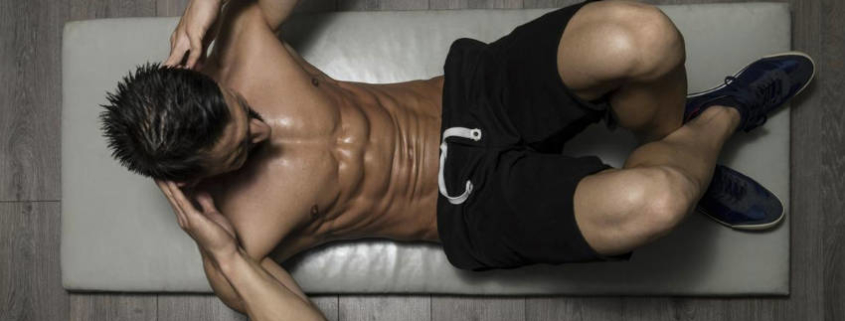Crunches are bad for your back
Any repetitive exercise, with or without load, where the lumbar spine is allowed to flex, round, or flatten, will over-stress the discs and ligaments.
Stuart McGill, a professor of spine bio-mechanics at the University of Waterloo, Canada.
Crunches and sit-ups involve lying on your back and repeatedly bending and extending your spine. Any forward bending motion of the torso such as sit-ups, crunches, rope pull-down crunches, toes to bar, knee to elbows, roll downs or touch our toes causes a significant increase in lower back intradiscal pressure. No matter how strong your core is, if repetitive bending (lumbar flexion) is done enough times then the posterior lower back disc fibers become overstretched, strained, weaken and gradually tear which can result in chronic low back pain, or even disc prolapses.
Don’t think because it doesn’t hurt yet it is O.K. to do crunches. Each of your spinal discs is only able to support a limited number of bending motions over the course of your lifetime. Does it make sense to perform exercises that can create common back injuries? The fact is, our abdominal muscles are not designed for large length change, or to help us flex our torso hundreds if not thousands of times. When doing any movement athletic or otherwise, the muscles of the spine, are designed to create spinal stability and help maintain a natural lordosis concave arch in the lumbar spine in order to protect it. The abdominal muscles in no way can raise the legs. The abdominal muscles purely stabilize the torso while the iliopsoas and rectus femoris raise the legs.
The best way to train work your torso is to do movements that challenge the muscles to perform the way they’re designed and expected to work in real life, and not to train muscles in isolation. Crunches don’t replicate any natural movement our bodies were designed for. Our bodies thrive on exercises in alignment with their function as nature intended. Crunches actively oppose the purpose of the spine and work against it. Over trained upper abdominals shorten and pull the upper body forward creating a slightly stooped posture that increases loading of the lower back. The muscles forming the trunk and pelvis must be balanced and when under load be simultaneously activated to allow the spine to retain it natural curves and protect the spine from unnecessary wear and tea. If you concentrate on strengthening only one set of muscles within the core, you can destabilize your spine by pulling it out of alignment. Functionally, the hips and shoulders are designed to create power and movement and move as one powerful unit.
Osteopaths are trained to understand the anatomy and biomechanics of the spine, which includes injury mechanisms of the spine which is important for injury avoidance and improved performance. If you have back pain, you want exercises that stabilize the spine, not move it. Osteopathic management, diagnosis and treatment help to restore proper motion and biomechanics to the spine, easing pain and dysfunction in the spine. Knowing and addressing your biomechanics will insure that you can begin or continue exercising without being injured. How many people start exercising, get injured, and then stop?
In a study conducted in 2001 by McGill on disc herniation and its relationship to repetitive spinal flexion, he found that the damaging mechanism leading to a herniation requires repeated flexion with only very modest loading on the spine. This trauma accumulates over time with very little indication to the individual, and weakens the discs.
View a list of common complains that Osteopathy can assist with
Discovery the benefits of Osteopathy
- What is Osteopathy?
- Adult health issues
- Babies and Children
- During and after pregnancy
- Common Complaints
- Testimonials
- Sports Injuries
- Genral Osteopathy FAQs
- The Science & Reasearch



